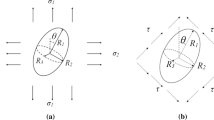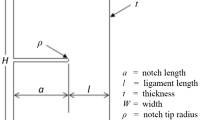Abstract
An elastic-plastic analysis was used to accurately measure the microscopic cleavage strength σ sup*inff of notched bars of high nitrogen steel in bending. It was found that σ sup*inff increases as the root radius of the notch ϱ decreases. For ϱ > 0.010″, the variation of σ sup*inff with ϱ, and the difference between σ sup*ingff and the cleavage fracture strength of a plane tensile specimen, σf, may result from a statistical effect, due to differences in the volume of highly stressed material in the plastic zone. For ϱ < .010″, the primary reason for the apparent increase in σ sup*inff with decreasing ϱ, is the steep stress gradient at the notch tip, which forces the critical plastic zone size to extend further to insure that unstable microcraek propagation can occur. Both the statistical and stress gradient effects have been quantitatively evaluated and found to be in good agreement with the experimental data.
Résumé
Une analyse élastoplastique a été utilisée pour la mesure précise de la résistance microscopique du clivage σ sup*inff de barreaux entaillées d'acier à haute teneur en azote et soumis à flexion.
On a trouvé que σ sup*inff s'accroit lorsque diminue le rayon d'arrondi ϱ à la racine de fentaille. Lorsque ϱ est supérieur à 0,25 mm, la variation de σ sup*inff en fonction de ϱ est due à un effet statistique du aux différences de volume de matière soumis, dans la zone de déformation plastique, à des contraintes; élevées. Il en est également de même l'écart entre σ sup*inff et la contrainte de rupture par clivage dune éprouvette de traction sans entaille.
Lorsque ϱ est inférieur à 0,25 mm, la raison principale de l'accroissement de σ sup*inff avec des valeurs de ϱ décroissantes réside dans l'existence d'un gradient aigu des contraintes à la pointe de la fissure. Un tel gradient force à s'accrcître lesdimensions de la zone critique de deformation plastique, pour que puisse se produire une propagation instable dune microfissure.
On a pu évaluer quantitativement ces effets statistiques d'une part et de gradients de contraintes d'autre part, et l'on s'est trouvé en accord satisfaisant avec les données expérimenetales.
Zusammenfassung
Man benutzte eine elastisch-plastische Analyse, um die miktoskopische Spaltungssärke σ sup*inff von eingekerbten Stahlbarren mit hohem Stickstoffgehalt im Krümmen sorgfältig zu messen. Man stellte fest, dass σ sup*inff sich vergrösserte während der Wurzelradius der Kerbe ϱ sick verringerte. Da ϱ > 0.010″ ist, ist die Variation von σ sup*inff mit der Spaitungsfrakturstärke einer planaren Spannungsprobe, σf durch einen statistischen Effekt und durch Unterschiede in dem Volumen von stark angespanntem Material in der plastischen Zone verursacht. Da ϱ > 0.010″ ist, ist der ursprüngliche Grund für die augenscheinliche Zunahme in σf mit verringertem ϱ, der tiefe Anspannungsgradiente an der Kerbenspitze, durch welche sich die kritische, plastische Zonengrösse weiter ausdehnen muss, um die labile Mikrorissausbreitung zu sichern. Die statistischen und Anspannungsgradienteffekte wurden quantitative ausgewertet und man fand gute Übereinstimmung mit den experimentellen werten.
Similar content being viewed by others
References
Wilshaw, T.R. and Pratt, P.L., J. Mech. Phys. Solids, 14, 1 (1966).
Wilshaw, T.R., Rau, C.A., fetelman, A.S., Engineering Fracture Mechanics, Vol. 1, 1968.
Hill, R.,‘Mathematical Theory of Plasticity’, Oxford, London (1950).
Hendrickson, J.A., Wood, D.S. and Clark, D.S., Trans. ASM, 50, 656 (1958).
Knott, J.F. and Cottrell, A.H., J.I.S.I., 201, 249 (1963).
Wilshaw, T.R. and Pratt, P.L., Int. Conf. on Fracture, Sendai, Japan, 1965, B III, 3.
Knott, J.F., J.I.S.I., 204, 104, (1966).
Tetelman, A.S. and McEvily, A.J., Fracture of Structural Materials, Wiley, New York (1967).
Cottrell, A.H., Proc. Roy. Soc., A285, 34 (1965).
Shoemaker, A.K., Fracture Toughness Testing, ASTM 381, p. 26 (1965).
Mulhern, J.H., Armiento, D.F., Markus, H., J. Basic Eng., p. 709 (1964).
Hahn, G.T., et al., Fracture, Wiley, New York (1959), p. 91.
McMahon, C.J. and Cohen, M., Acta Met., 13, 591 (1965).
Kaechele, L. and Tetelman, A.S.,to be published in Acta Metallurgica.
Weibull, W.,Proc. Roy. Swed. Inst. for Eng. Res. 151, (1939).
Author information
Authors and Affiliations
Rights and permissions
About this article
Cite this article
Tetelman, A.S., Wilshaw, T.R. & Rau, C.A. The critical tensile stress criterion for cleavage. Int J Fract 4, 147–156 (1968). https://doi.org/10.1007/BF00188941
Issue Date:
DOI: https://doi.org/10.1007/BF00188941




